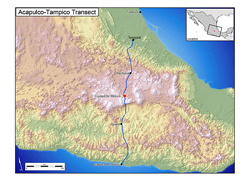MesoAmerican Subduction Experiment (MASE)
MASE Home |
People |
Science |
Data |
Publications |
Outreach |
Images |
Relevant Links
MASE is a cooperative project involving the Tectonics Observatory (TO), Caltech; the Institutes of Geophysics and Geology, UNAM; the Center for Embedded Network Sensors (CENS), UCLA; and the Center for Geosciences, UNAM.
We seek to combine theory and observation into a dynamic model of the evolution of a subduction system over tens of millions of years, including the thermal and compositional state of the mantle wedge and melt production, the shape of the slab, coupling between the overriding and downgoing plates, thermal history of the upper plate, and forces operating on the entire system.
We choose the Central America subduction zone as a good location to study this problem, because significant variations in behavior and characteristics along strike are present there. These variations do not appear to correlate with slab age or plate convergence rate. However, they may be controlled by thermal or compositional variations in the mantle wedge itself, by features that were riding on the downgoing plate and subsequently were subducted, or by characteristics of the subduction interface itself. The geochemistry of the magmatic rocks in this region has the potential to record the temperature, water content, source region, and the type and extent of melt in the mantle wedge.

The MASE array of 100 seismometers crossing Mexico
|
We intend to construct a dynamical (numerical) model of the subduction process that matches the variety of subduction scenarios present in the Central America subduction zone. The parameters for the model will be determined from data that already exist in the region and from surveys we will conduct ourselves.
Research highlights

The unusual case of the Mexican subduction zone
|
|

